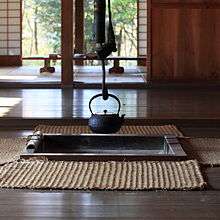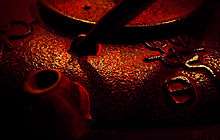Tetsubin

Tetsubin (鉄瓶) are Japanese cast iron pots having a pouring spout, a lid, and a handle crossing over the top, used for boiling and pouring hot water for drinking purposes, such as for making tea.
Tetsubin are traditionally heated over a charcoal fire. In the Japanese art of chanoyu, the special portable brazier for this is the binkake (瓶掛). (See list of Japanese tea ceremony equipment). Tetsubin are often elaborately decorated with relief designs on the outside. They range widely in size, and many have unusual shapes, making them popular with collectors. A relatively small tetsubin may hold around 0.5 litres of water; large ones may hold around 5 litres.

The historical origin of the tetsubin is not certain.[1] At least one authoritative Japanese source[2] states that it developed from the spouted and handled water kettle called tedorigama that was already being used in chanoyu in the era of Sen no Rikyū (1522–91). During the 19th century, infused tea became more popular and tetsubin were considered primarily status symbols rather than functional kitchen items.
There is also a kind of relatively small cast iron pot that resembles a tetsubin but is glazed with enamel on the inside in order to lend itself to making brewed tea, and is referred to as an iron kyūsu (急須) or teapot. Most often, however, ceramic is used for making kyūsu. Kyūsu often come with a tea strainer that fits inside.
The prefectures of Iwate and Yamagata are best known for producing tetsubin as well as iron kyūsu.
History
It is not clear when the first tetsubin pots appeared in Japan, but one hypothesis is that the popularity of the tetsubin pot grew alongside sencha, a form of leaf tea. China introduced Japan to sencha around the middle of the 17th century.[3] Sencha was not considered as formal as matcha, the common powdered green tea at the time. Throughout the 18th century, people started drinking sencha as an informal setting for sharing a cup of tea with friends or family. As more people drank sencha, the popularity of the tetsubin grew. The tetsubin pot is most probably not an original design, but rather shaped by other pots around at the time. The five closest relatives to the tetsubin are the tedorikama, the toyama, the mizusosogi, the dobin, and the yakkan. The yakkan is the closest relative to the tetsubin, the main difference is that the yakkan is made from copper, whereas tetsubins are traditionally made out of iron. Some people have wondered why the tetsubin was developed, when a perfectly usable vessel such as the yakkan would have worked. Tea drinkers may have preferred the taste of water from an iron pot over the taste of water from a copper pot. Throughout the 18th century, tetsubin kettles became a standard household utensil for heating water to make tea with. As the use of these pots increased, so too did the intricacy. During the 19th century, tetsubin designs went from simple basic iron kettles, to elaborately engraved masterpieces.
See also
- Cast iron cookware
- Japanese tea ceremony
- Kyusu, traditional Japanese teapots typically with side handles
- Teapot, a vessel with a spout and handle, typically ceramic, from which tea is brewed and served
References
- ↑ History of Tetsubins.
- ↑ Genshoku Chadō Daijiten 原色茶道大辞典: Tankosha, 1975. Japanese illustrated encyclopedia of "the way of tea", entry for "tedorigama".
- ↑ "History of the tetsubin". Retrieved 30 December 2011.
External links
| Wikimedia Commons has media related to Tetsubin. |